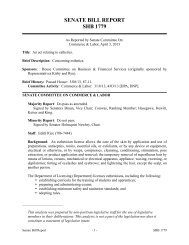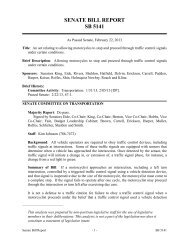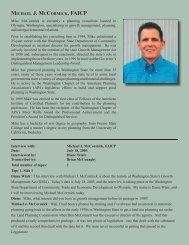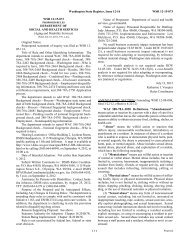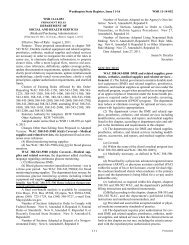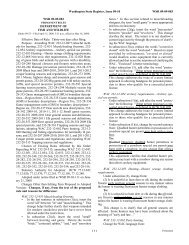Proposed
Proposed
Proposed
Create successful ePaper yourself
Turn your PDF publications into a flip-book with our unique Google optimized e-Paper software.
cal nonmetallic tubing (when installed within a building or<br />
crawl space). Aluminum conduit is not permitted.<br />
040 Spas and hot tubs.<br />
(11) NEC 680.42(C) will apply for interior and exterior<br />
wiring to outdoor installations of spas and hot tubs.<br />
070 Hydromassage bathtubs.<br />
(12) For hydromassage bathtubs, the ground fault circuit<br />
interrupter device must be identified as to use and not located<br />
in a building or tub cavity, crawlspace, or attic.<br />
(13) For hydromassage bathtubs, all electrical equipment<br />
installed to support the bathtub (e.g., disconnecting means,<br />
motor, etc.) must be accessible at the same grade level as the<br />
tub or from a landing on the exterior of the building without<br />
the use of a ladder or other access device.<br />
AMENDATORY SECTION (Amending WSR 09-20-032,<br />
filed 9/29/09, effective 10/31/09)<br />
WAC 296-46B-690 Solar photovoltaic systems.<br />
002 Definitions.<br />
(1) ((Photovoltaic system. The photovoltaic system may<br />
conduct alternating current, direct current, or both and will<br />
comprise all interconnected circuits to the point of connection<br />
with the building distribution circuits or utility service<br />
conductors.)) Building integrated means: Photovoltaic cells,<br />
modules, panels, or arrays that are integrated into the outer<br />
surface or structure of a building and serve as the outer protective<br />
surface of that building, such as the roof, skylights,<br />
windows, or facades.<br />
004 Installation.<br />
(2) Support structure((,)) or foundation((, and tracker)).<br />
For the purposes of this section, those portions of the ((array<br />
or tracker)) structure support or foundation that are exclusively<br />
mechanical and are ((built specifically for the purpose<br />
of physically supporting the modules or panels)) not part of a<br />
bonding or grounding path will not be considered part of the<br />
photovoltaic system as defined by this ((article)) section.<br />
Such structural support or foundation may be done by the<br />
owner, registered general contractor, or licensed electrical<br />
contractor without electrical permit or inspection.<br />
((004 Installation.))<br />
(3) A photovoltaic system design review must be ((submitted))<br />
provided at the time of the first inspection. ((The<br />
design review must be available to the inspector on the job<br />
site. Permit holders must submit, to the electrical authority<br />
having jurisdiction, copies of the photovoltaic equipment<br />
manufacturer's installation information, accompanied by a<br />
legible one-line diagram of the photovoltaic design and calculations<br />
used to determine voltage and current within the<br />
photovoltaic system. This diagram must show the photovoltaic<br />
equipment, devices, overcurrent protection, conductor<br />
sizing, grounding, ground fault protection if required, and<br />
any system interconnection points.))<br />
(4) For utility interactive systems, persons making interconnections<br />
between solar photovoltaic system and the utility<br />
distribution network must consult the serving utility and are<br />
required to meet all additional utility standards.<br />
(5) The entity placing a building integrated cell, module,<br />
panel, or array is not subject to the requirements for electrical<br />
inspection, licensing, or certification so long as the work is<br />
Washington State Register, Issue 12-21 WSR 12-21-103<br />
limited to the placement and securing of the device and an<br />
electrical work permit has been previously obtained for the<br />
electrical work related to the equipment by an entity authorized<br />
to do that electrical work.<br />
(6) All electrical work, including wiring installation, terminations,<br />
etc., necessary to complete the electrical installations<br />
must be completed by the entity authorized to do the<br />
electrical work (i.e., owner or appropriate electrical contractor).<br />
007 Maximum voltage.<br />
(((5))) (7) The open-circuit voltage temperature coefficients<br />
supplied in the instructions of listed photovoltaic modules<br />
will be used to determine the maximum direct current<br />
photovoltaic system voltage. Otherwise the voltage will be<br />
calculated using Table 690.7 of the NEC. For the purposes of<br />
this calculation, a temperature correction factor of 1.25 will<br />
be used unless another factor can be justified and is approved<br />
by the authority having jurisdiction.<br />
053 Direct-current photovoltaic power source.<br />
(((6))) (8) All photovoltaic equipment and disconnecting<br />
means must be permanently identified as to their purpose,<br />
maximum voltages, and type of current within the system<br />
with an identification plate. All photovoltaic circuits must be<br />
identified at each overcurrent protection device(s) and panel<br />
directory(ies).<br />
(((7))) (9) Required "WARNING" labels as specified by<br />
NEC 690 are required to be an identification plate on or<br />
immediately adjacent to the pertinent equipment.<br />
AMENDATORY SECTION (Amending WSR 06-24-041,<br />
filed 11/30/06, effective 12/31/06)<br />
WAC 296-46B-800 Communications systems—Communications<br />
circuits.<br />
General.<br />
Chapters 1 through 7, NEC, supplement and modify the<br />
requirements of chapter 8, NEC. If there are specific requirements<br />
or exceptions described in chapter 8, NEC, that are different<br />
from those in chapters 1 through 7, NEC, chapter 8 will<br />
prevail.<br />
001 Installation.<br />
(1) All telecommunications installations on an end-user's<br />
property, beyond the end-user's telecommunications network<br />
demarcation point, made by a telecommunications service<br />
provider, both inside and outside of a building or structure,<br />
must conform to all licensing, certification, installation, permitting,<br />
and inspection requirements described in chapter<br />
19.28 RCW and this chapter.<br />
(2) Telecommunications service providers including its<br />
subcontractors and agents must install and maintain points of<br />
demarcation in conformance with Code of Federal Regulations<br />
(C.F.R.), Title 47, Chapter 1, Part 68, Subpart B, Sec.<br />
68.105 and may not place a point of demarcation further than<br />
twelve inches within an end-user's occupied space.<br />
(3) The telecommunications service provider must identify<br />
the telecommunications network demarcation point(s)<br />
with an identification plate or label having:<br />
(a) The provider's name;<br />
(b) Customer/end-user's name; and<br />
(c) If a CWSTP is used, the option type used.<br />
[ 51 ] <strong>Proposed</strong>



